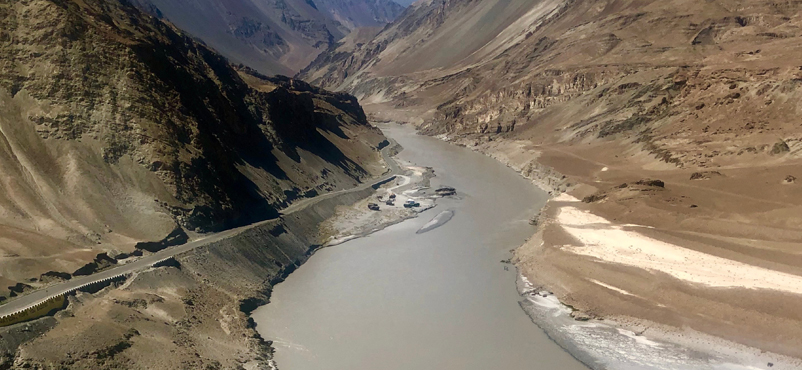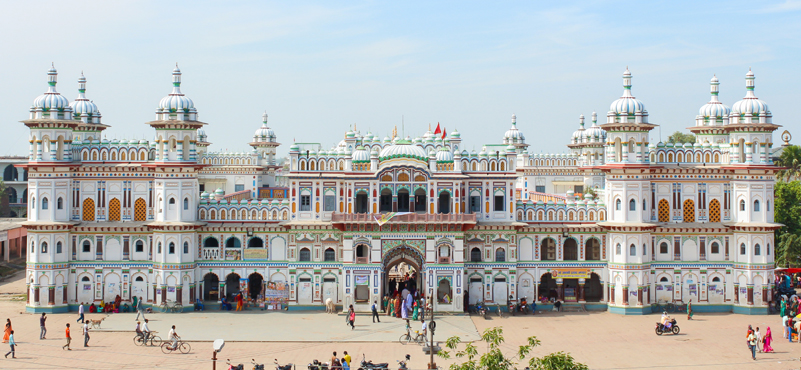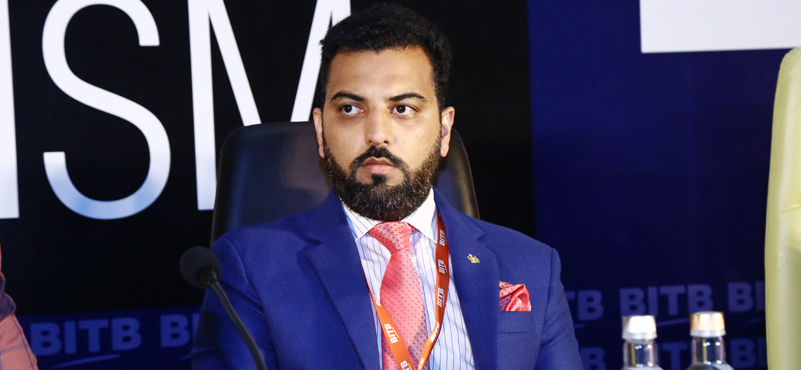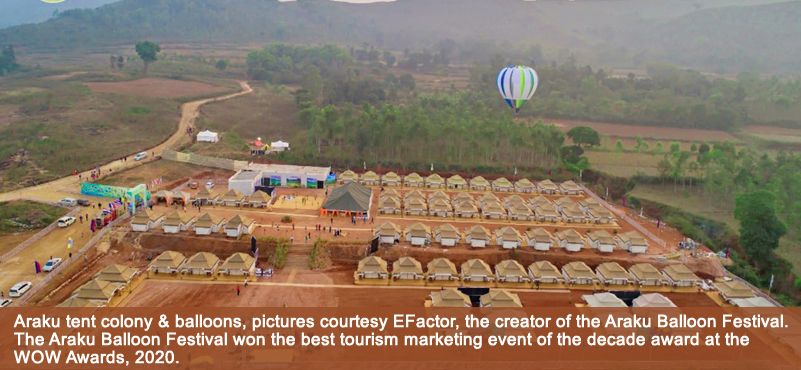A month after the creation of Ladakh as a Union Territory, Amita Sarwal spent a week there.
She, met various Ladakhis, visitors, and tour operators. Each one had a similar concept – advocating and upgrading Ladakh’s charms!
Standing majestically on a hillock, is the circa-1820 Stok Palace, a recognised landmark in Ladakh. Residing here, in what has been turned into a boutique heritage hotel, is H.E. Raja Jigmed Wangchuk Namgyal.
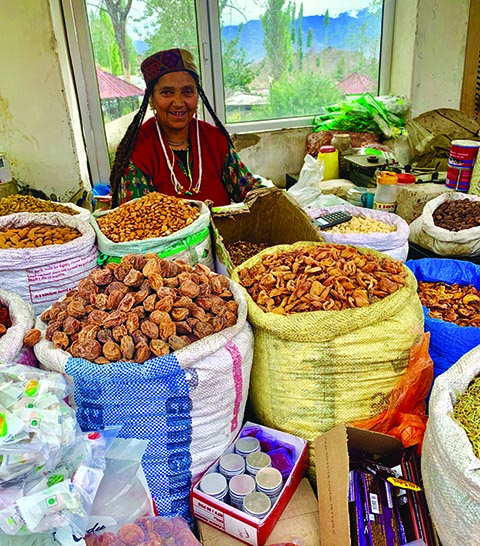
The owner is well aware that the dynamics of development, hence forth are challenging. Yet he is optimistic about the future of Ladakh with its recently attained status as Union Territory.
Over a cup of coffee in Stok’s sunlit Chulli Bagh villas complex, surrounded by tall, slender polar trees and apricot orchards, Namgyal spells out his plans, pertaining to Ladakh’s prime USP – tourism.
“I have a Master Plan for overall development for the region of Ladakh. We also need to continue safe guarding our heritage for future generations. One of the intents is to request Government of India to give tourism an industry status. This will decentralise the sector so that the people of Ladakh can get better job opportunities. It will also provide openings and prospects for equal growth to other destinations within Ladakh. Priority would be to create world-standard infrastructure and facilities for travel, tourism and hospitality. In addition, related institutes should be set up for teaching and learning. Things are changing, but we now hope, as a Union Territory, these changes will come faster,” Namgyal, 50, states about a land mass which has so much to offer.
According to reports, 3,27,366 inbound tourists, including 49,477 foreigners visited Leh in 2018, marking an increase of over 50,000 visitors compared to the previous year. (Source: a senior official of the state tourism department.) “The Responsible Tourism Collective Ladakh, under process of being formed, will comprise a group of businesses that are actively involved in, or pertaining to engage tourism-related activities. These would be well on their way to achieving a sustainable, responsible and ethical business approach. The Collective shall bring together various sustainability advisors to empower not only the business members but also the tourists and travelers to Ladakh’s respective destinations. Attracting and expanding the appropriate market of conscious consumers is our key objective,” affirms Namgyal.
The Collectivefs threefold objective is:
- Market linkages/Promotions: Create direct market linkages showcasing these businesses to the right audience and end user.
- Sustainability enablement: Enable member businesses to incorporate, improve and maintain sustainability principles in the functioning of their practices.
- Policy advocacy: For advice on sustainable tourism practices and policies with local, national and international tourism bodies.
Further, Collective members could be classified into (but may not be restricted to) catering to Heritage or Adventure tourism, Restaurants, Accommodation and Experiential sightseeing. The Collective’s platform will enable responsible and sustainable businesses to exchange ideas and build a framework for activating other businesses, tourism stakeholders, policy makers and consumers to transition towards the same methodology.

Ladakh’s strong initiative will be given relevant exposure through media releases, social media, website, road shows and other marketing tools.
Realising the significance of education for this industry, Namgyal affirms the Collective will partner with educational institutions by offering a series of talks and lectures. Internship and volunteer opportunities will also be made available to students with an aim to raise awareness of the significant career opportunities within a responsible tourism industry.
In the distance, Ladakh’s spectacularly jagged, stark mountains embracing the mystical Buddhist ex-kingdom of, lying at a height of over 3,000 mt., also known as the cold desert, forms the highest plateau in the region.
Strategically located at the crossroads of important trade routes of a distant past, it is now opening its doors to welcome not only tourists but educationists, industrialists, developers, healthcare specialists and corporate professionals.
In the land of centuries old gompas, (Tibetan Buddhist monasteries), their interiors dramatically awash with colourful, intricately detailed hand-painted murals, whitewashed stupas and statuary of countless bodhisattvas. Bright, fluttering prayer flags share their spiritual messages metaphorically, while prayer wheels spinning clockwise, resound with the chanting of ‘Om Mani Padme Hum’ and other eloquent mantras. Ribbon-smooth black bitumen highways lead to and from Ladakh – built to perfection by the numerous Army battalions posted across the land.
Despite a variation of temperatures from a warm 22 degrees in summer to a chilling -20 degrees in winter, and lying in a rain shadow area, Ladakh gets only 10-15 rainy days annually in June and July. Taking advantage of the brilliant sunny days, solar panels dot the landscape increasingly as an alternative, natural source of electricity.
“Living here has a different meaning in timelessness. It is a privilege, an honour, and most importantly a sense of responsibility, to preserve, conserve and restore the rich, genteel legacy of Ladakh,” Namgyal signs off.
The Stock Palace Heritage Hotel
Built by Ladakhi craftsmen, the Stok Palace continues to be the sheltered abode of the Namgyal Dynasty.
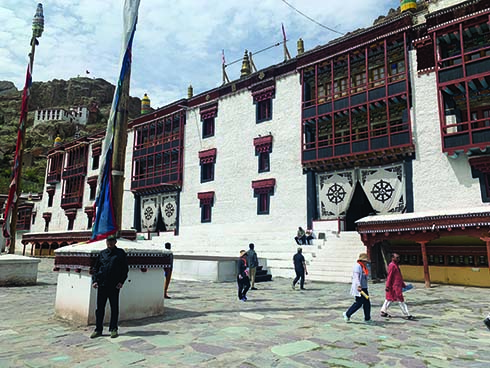
It traces its origin to its 10th century founder Lhachen Palgygon. With its 198 years of history that encapsulates the lifestyle of the rulers of Ladakh, the Palace was blessed by His Holiness the Dalai Lama in 1980 when it opened its doors as an experiential heritage hotel for discerning global travellers.
Elegantly preserved, with H.E. Jigmed Wangchuk Namgyal personally and meticulously masterminding the restoration, he reveals, “We used traditional methods and elements, which helped revive a dying craft. The original furniture and textiles were sensitively reconditioned and are being used in the guest suites.”
Aditya Mukherji, GM, Stok Palace Heritage Hotel then adds, “Tourism is changing the ethos of Ladakh, just as urbanisation does in most places that it touches. Our endeavour at Stok Palace is to create spaces and experiences which leave our guests with more to think about and take back than just a pretty place. Tourism need not just be about the sights and sounds, but rather encapsulate the way of life of the destination. It is also an understanding of a philosophy which can be imbibed in our daily lives (that has been lost in our urban chambers). Our success lies in providing a unique experience to our guests amidst the culture and heritage of Ladakh.
Mukherji then continues, “In comparison, the experience at Chulli Bagh, set amidst fruit orchards, offers a totally different holiday. Chulli Bagh villas are constructed using conventional Ladakhi building materials – stone, wood and mud – as used in the 200-year old palace. Staying in such a traditional building fitted with contemporary amenities, is an interesting juxtaposition of the old and new.” www.stokpalaceheritage.com
Gyapthago Heritage Home
Jigmet (Jimmy) Rafstan, 26, is the 7th generation resident of the two-century old Gyapthago home.
 Located in Stok Village, about 17 km from Leh, six years ago his parents converted their ancient home into a heritage museum – and built a new homestay alongside.
Located in Stok Village, about 17 km from Leh, six years ago his parents converted their ancient home into a heritage museum – and built a new homestay alongside.
“In 2013, we built a two storey home on our premises, conserving the Ladakhi architectural style using local materials and craftsmen. Yet fitted with contemporary conveniences. The aim is to preserve and spread our rich and unique local culture and traditions,” says Tsewang Paldan, 51, his father.
Upon completing his graduation from Punjab University, Jimmy joined the family enterprise of further restoring and growing the Gyapthago business.
“I am now working on improving and upgrading the home-museum, retaining much of the original interiors as they were during the days of my forefathers,” says Jimmy.
Climbing up narrow steps over three levels, gave a peek into the lifestyle of a well-to-do Ladakhi family who lived here for generations. The central, spacious kitchen remained the focal gathering place.
Jimmy’s mother, Tsewang Yangzes, 46, takes care of the kitchen and serves delicious traditional Ladakhi meals for the guests in the homestay unit. “I am very happy to cook local traditional food for our guests.
The meal starts with butter tea, followed by local dishes for which we grow our own vegetables, and ends with a wet apricot dessert. I love interacting with, and meeting new people. It’s a joy for me to earn some extra money from serving these meals,” she says as she demonstrates making butter tea for us in a conventional, long cylindrical gurgur, which she served with snacks.
During summer months the front garden blooms with flowers and an abundance of vegetables, providing adequate fresh, organic provisions for the guests’ meals. The authentic local cuisine served here has become so popular, that Gyapthago is now on the tourist circuit and draws a fair share of visitors coming for meals.
Jimmy says, “To run a small business like ours, there are challenges like paucity of accommodation. We are looking at building another home on the premises to add more rooms to cope with the demand. At present we have five rooms and can accommodate 15 guests simultaneously.”
 “We are very happy at Ladakh being granted Union Territory status. But we are a bit concerned and fearful for our land, our environment and job protection. We hope our concerns will be kept in mind and everything will be for a good cause. The positive thing is that Ladakh will develop at a rapid pace and provide more opportunities of education and employment for our young ones. Now we will get direct funding from the Central government and look at a future viewed through many perspectives,” sums up the patriarch, Paldan.
“We are very happy at Ladakh being granted Union Territory status. But we are a bit concerned and fearful for our land, our environment and job protection. We hope our concerns will be kept in mind and everything will be for a good cause. The positive thing is that Ladakh will develop at a rapid pace and provide more opportunities of education and employment for our young ones. Now we will get direct funding from the Central government and look at a future viewed through many perspectives,” sums up the patriarch, Paldan.
Tel: +91-9906881323, +91-9419218421/ +91-9622966413; Facebook: gyapthagoheritaghome
Instagram: gyapthago_heritage
Homestays & Organic Manure
In early 2000, Delhi-based Royal Expeditions, a luxury, boutique in-bound operator had “pioneered snow leopard treks for international travelers in Ladakh that supported Snow Leopard Trust India, and its research work. Subsequently, we started landscape photography tours,” introduces Managing Director, Vishal Singh.
“Ladakh’s fragile ecosystem has been suffering from over tourism thanks to Bollywood. We need to focus on shifting from irresponsible to responsible tourism,” says Singh, 49, a founding and current board member of TOFT (Tour Operators for Tigers India Wildlife Association).
He continues, “Ladakh’s water and trash management are concerns as the fragile trans-Himalayan ecology cannot sustain the burden. One such example – Leh town, like elsewhere in Ladakh, is highly dependent on spring water for domestic use. Of late, the town has seen an exponential rise in concrete hotels and guest houses – each with a modern toilet and showers, requiring 24×7 water supply. Next, tourism activity should strictly be green and clean with fees for adventure activity. For irresponsible campers and trekkers, funds generated can be used to clean up the area.”
 Having customised itineraries for HNI’s, dignitaries, royal families and discerning travelers since 1993, Singh cautions, “While increased tourism will raise income levels and economic opportunity, communities will be challenged to accommodate visitors sustainably. This has to translate to a balance of minimal impact on resources, environment and biological diversity while protecting the surroundings. It is critical and perhaps. But it is possible.”
Having customised itineraries for HNI’s, dignitaries, royal families and discerning travelers since 1993, Singh cautions, “While increased tourism will raise income levels and economic opportunity, communities will be challenged to accommodate visitors sustainably. This has to translate to a balance of minimal impact on resources, environment and biological diversity while protecting the surroundings. It is critical and perhaps. But it is possible.”
“Sustainable tourism means choosing boutique lodges or homestays offering traditional Ladakhi lifestyle, over large, contemporary hotels. For example, by using the traditional Ladakhi dry toilet, you save water, prevent further water pollution, and contribute to the most important ingredient in Ladakhi farm practice – dried human excreta used as organic manure,” Singh signs off.
Discourage crass commercial
“With Ladakh’s union territory status it is imperative that an empowered and well-funded QUANGO (Quasi Autonomous Non-Governmental Organisation) is established to focus on tourism development. The past decade, word-of-mouth publicity from travelers has generated increased visitor arrivals year on year.
There is no gainsaying what a concerted effort would do,’ introduces Rajesh Ojha, 54, Founder Director, Banjara Camps & Retreats (estab. 1993). Ojah, a reputed pioneer in hospitality and soft-adventure travel for the domestic sector, operates five mountain lodges in Himachal Pradesh. He also runs customised jeep safaris and treks from Kashmir to Ladakh, and further in Arunachal Pradesh and Tibet.
Ladakh being Ojha’s passion, he offers experiential suggestions. “Except Leh, Kargil and Nubra Valley, most places have basic accommodation. It is important to concretise, and simultaneously discourage crass commercialisation. Regulations on maintaining architectural integrity in emerging new properties; developing homestays with modern facilities, and monastery guesthouses should be priortised. Secondly, there are lacunas in wifi connectivity on long stretches on road trails and remote places. I feel, air fares to and from Leh are prohibitive.”
On promoting winter tourism, Ojha highlights, “Ladakh’s attractions are snow leopards and other exotic Himalayan fauna; walking on frozen rivers and lakes, and experiencing hot sulphur springs of Panamik.”
Finally, Ojha voices the industry’s concerns. “Ladakh must regulate a sustainable and eco-friendly model for future developments. The high tourism potential can usher prosperity in every nook and corner, but needs stringent management so benefits are long lasting. And it just doesn’t turn into a case of Cooking the Golden Goose.”
– Text by: Amita Sarwal
Photographs by: The Stok Palace Heritage Hotel / Tiger Tops’ Ladakh Gathering Group / Gyapthago Heritage Home & Amita Sarwal
Ladakhis’
Optimistic Views
“As a contractor, hopefully, there will be more scope of work in every government department. There will be sufficient funds to invest by the government in new sectors of development. Now there will be no pending bills, unlike in other states,” says 27-year old Jamyang Namgyal, Proprietor, Namgyal Tubewell and Drilling Co.
Entrepreneur Rigzin Yangjor, 26, who has shops selling school and college uniforms, fancy accessories, and also pets, says positively, “As a businessman I feel there will be many more good opportunities. Even unemployed youth, upon completing their studies, can consider becoming entrepreneurs because of the rich resources available in Ladakh. But job protection is a must after Ladakh becomes UT….”
A teacher who prefers anonymity says, “Particularly government teachers are happy because in the foreseeable future there will be medical and engineering colleges being established as part of Ladakh University. Earlier we dealt with many issues. But are confident after becoming UT, higher education for students will improve and provide more options in Ladakh.”
Team Tiger Tops In Ladakh
Former Buddies Of The Erstwhile Company Reunite
Early September, about 40 friends from USA, Europe, Australia, UK, Nepal and India congregated in Ladakh. The common link – all long-term ex-staffers of Tiger Tops.
Though Tiger Tops Indian operations closed down long ago, the bond created between colleagues in the formative years, has remained strong over the ensuing decades.
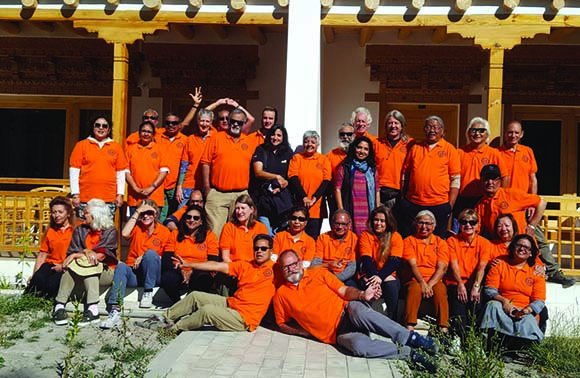 Tsering Angdu, an integral part of Ladakh Sarai and owner of The Golden Retreat Stok, hosted the five-days reunion, with co-host Raja Jigmed Wangchuk Namgyal, on whose land the original Ladakh Sarai once stood.
Tsering Angdu, an integral part of Ladakh Sarai and owner of The Golden Retreat Stok, hosted the five-days reunion, with co-host Raja Jigmed Wangchuk Namgyal, on whose land the original Ladakh Sarai once stood.
Time seemingly stood still during the reunion where the collective focus was just to raise a glass and say ‘Juley’! The group comprised former naturalists, trek managers, river guides and associates from erstwhile Tiger Tops’ Kathmandu and New Delhi offices.
“We had been ideating on this for over one year. It got in line once responses started coming in. For me, it was great to see everyone on board and reuniting with many after decades. Since we all are part and parcel of Hospitality, it creates opportunities to work together and promote Ladakh in the best possible manner through our chain of friends,” says Jigmed.
Tiger Tops, a small hunting lodge in Chitwan, Nepal, was taken over by Jim Edwards and Chuck McDougal, from its American owners in 1971. The duo turned it into a flag bearer of linking wildlife tourism with conservation in the Indian subcontinent. Subsequently, Tiger Tops and Col Jimmy Roberts’ Mountain Travel joined hands.
The Indian chapter started end-1970 when Col. John Wakefield (Papa John’s) set up the Kashmir and Ladakh operations.
A host of naturalists, trained in Nepal, opened almost all of Ladakh’s trekking routes still operational today. Among them are Alok Chandola, Jeff Campbell, Hashim Tyabji, Inderjit Singh, Shiv Kunal Verma and Rahul Sharma.
White water rafting on the Indus was set up by Ronesh Mehra. Ashish Chandola (Anglia Films) and Shiv Kunal Verma (Project Tiger television series for Sanctuary Films) have become reputed documentary film makers.
In 1979 Ladakh Sarai was set up in Stok village, initially, comprising Mongolian canvas and bamboo yurts (tents). Later, sun-baked Ladakhi brick structures were set up.
Reminisces Vineeta Hoon who managed the Sarai (1981-82), “I revisited the ground where Ladakh Sarai was. I visualised where the yurts, the common eco-toilets and baths, the kitchen, dining and common rooms stood. The hustle and bustle of people was gone. The truly, classy eco-experience remains a happy, exotic dream…”
The Tiger Tops’ guests’ High Tea at Stok Palace was followed two days later with a Ladakhi Musical performance and dinner.
The ambience was ideal for reunifying old friends – set among willow trees in the Chulli Bagh resort, under a star studded, crescent moonlit night.
– Text by: Amita Sarwal
Photographs by: Tiger Tops’ Ladakh Gathering Group

